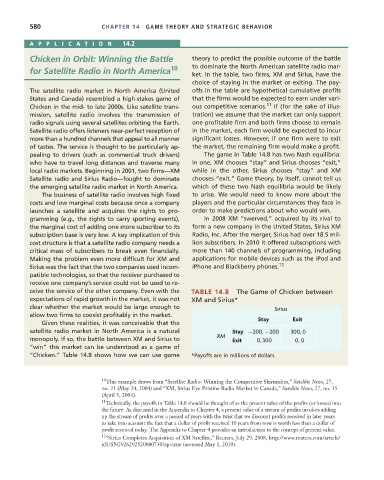Page 606 - Microeconomics, Fourth Edition
P. 606
c14gametheoryandstrategicbehavior.qxd 8/6/10 8:22 AM Page 580
580 CHAPTER 14 GAME THEORY AND STRATEGIC BEHAVIOR
APPLICA TION 14.2
Chicken in Orbit: Winning the Battle theory to predict the possible outcome of the battle
for Satellite Radio in North America 10 to dominate the North American satellite radio mar-
ket. In the table, two firms, XM and Sirius, have the
choice of staying in the market or exiting. The pay-
The satellite radio market in North America (United offs in the table are hypothetical cumulative profits
States and Canada) resembled a high-stakes game of that the firms would be expected to earn under vari-
Chicken in the mid- to late 2000s. Like satellite trans- ous competitive scenarios. 11 If (for the sake of illus-
mission, satellite radio involves the transmission of tration) we assume that the market can only support
radio signals using several satellites orbiting the Earth. one profitable firm and both firms choose to remain
Satellite radio offers listeners near-perfect reception of in the market, each firm would be expected to incur
more than a hundred channels that appeal to all manner significant losses. However, if one firm were to exit
of tastes. The service is thought to be particularly ap- the market, the remaining firm would make a profit.
pealing to drivers (such as commercial truck drivers) The game in Table 14.8 has two Nash equilibria:
who have to travel long distances and traverse many In one, XM chooses “stay” and Sirius chooses “exit,”
local radio markets. Beginning in 2001, two firms—XM while in the other, Sirius chooses “stay” and XM
Satellite radio and Sirius Radio—fought to dominate chooses “exit.” Game theory, by itself, cannot tell us
the emerging satellite radio market in North America. which of these two Nash equilibria would be likely
The business of satellite radio involves high fixed to arise. We would need to know more about the
costs and low marginal costs because once a company players and the particular circumstances they face in
launches a satellite and acquires the rights to pro- order to make predictions about who would win.
gramming (e.g., the rights to carry sporting events), In 2008 XM “swerved,” acquired by its rival to
the marginal cost of adding one more subscriber to its form a new company in the United States, Sirius XM
subscription base is very low. A key implication of this Radio, Inc. After the merger, Sirius had over 18.5 mil-
cost structure is that a satellite radio company needs a lion subscribers. In 2010 it offered subscriptions with
critical mass of subscribers to break even financially. more than 140 channels of programming, including
Making the problem even more difficult for XM and applications for mobile devices such as the iPod and
Sirius was the fact that the two companies used incom- iPhone and Blackberry phones. 12
patible technologies, so that the receiver purchased to
receive one company’s service could not be used to re-
ceive the service of the other company. Even with the TABLE 14.8 The Game of Chicken between
expectations of rapid growth in the market, it was not XM and Sirius*
clear whether the market would be large enough to Sirius
allow two firms to coexist profitably in the market.
Stay Exit
Given these realities, it was conceivable that the
satellite radio market in North America is a natural XM Stay 200, 200 300, 0
monopoly. If so, the battle between XM and Sirius to Exit 0, 300 0, 0
“win” this market can be understood as a game of
“Chicken.” Table 14.8 shows how we can use game *Payoffs are in millions of dollars.
10 This example draws from “Satellite Radio: Winning the Competitive Skirmishes,” Satellite News, 27,
no. 21 (May 24, 2004) and “XM, Sirius Eye Pristine Radio Market in Canada,” Satellite News, 27, no. 15
(April 5, 2004).
11 Technically, the payoffs in Table 14.8 should be thought of as the present value of the profits (or losses) into
the future. As discussed in the Appendix to Chapter 4, a present value of a stream of profits involves adding
up the stream of profits over a period of years with the twist that we discount profits received in later years
to take into account the fact that a dollar of profit received 10 years from now is worth less than a dollar of
profit received today. The Appendix to Chapter 4 provides an introduction to the concept of present value.
12 “Sirius Completes Acquisition of XM Satellite,” Reuters, July 29. 2008, http://www.reuters.com/article/
idUSN2926292520080730?sp=true (accessed May 1, 2010).

